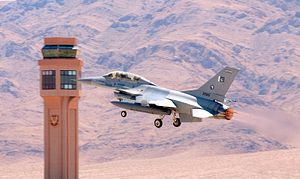The United States Congress is stalling efforts by the Government of Pakistan and the Obama White House to conclude the sale of eight F-16 jets to the Pakistan Air Force, the Pakistan-based Dawn newspaper reports.
According to the newspaper, “[t]he hold reflects the growing anti-Pakistan sentiments on Capitol Hill where it is now a routine to see strong attacks on Pakistan and its policies during congressional hearings.”
Dawn attributes the anti-Pakistan sentiment in Congress to the growing influence of a pro-India lobby, which the newspaper claims “has grown gradually in size and influence and is now the second most effective lobby after Israel’s.”
The Obama administration issued a formal notification of “Foreign Military Financing” in December 2015, which needs to be followed by a formal approval of a possible “Foreign Military Sale” to Pakistan by the U.S. State Department. However, even at that stage, U.S. Congress can still block the sale.
The article goes on to cite statements by Congressmen Ted Poe and Dan Rohrabacher as evidence for the anti-Pakistan sentiment prevalent among U.S. lawmakers.
“I don’t know how an F-16, with all of its hardware on there for combat can be used for humanitarian aid. If they were buying C-130s … I could see those being used for humanitarian aid. But F-16! It’s not really humanitarian aid,” Poe said. Rohrabacher noted that “[t]hose F-16s and the military equipment that we are providing Pakistan are being used against their own people, just like they did against the people over there in Bangladesh.”
Both lawmakers are members of the generally Pakistan-friendly Republican Party. However, U.S. lawmakers’ principal concern is that in reality the F-16s will not be used to battle militants within Pakistan but rather be deployed to deter India.
As I reported previously (See: “US Will Sell 8 F-16 Fighter Jets to Pakistan”), in March 2015, the U.S. House Committee on Foreign Affairs froze $150 million in foreign military financing and put a hold on the delivery of a number of used U.S. Navy cutter vessels since they were not deemed essential in fighting militants in Pakistan.
“We remain deeply concerned that Pakistan has failed to take meaningful action against key Islamist terrorist groups operating within its territory,” the committee’s chairman noted in a letter sent to the U.S. State Department in March.
The Pakistan Air Force (PAF) currently operates around 70 F-16s. As I explained in October 2015:
Forty F-16 fighters were first introduced to Pakistan’s Air Force (PAF) in the 1980s. However, due to the 1985 Pressler Amendment, the United States cancelled the sale of an additional 28 F-16s in 1990 and imposed sanctions on Pakistan because of its burgeoning nuclear weapons program.
In 2006, a contract was signed between the United States and Pakistan over the purchase of 18 new F-16C/D block 50/52 aircraft with an option for another 18 more. The first three F-16C/Ds were delivered in June 2010 with the rest inducted into the PAF by the end of 2012. That same year, the United States delivered 14 used F-16s to the PAF.
In April 2015, the U.S. State Department approved Islamabad’s request for the sale of military hardware that includes attack helicopters, missiles, and communications equipment at an estimated cost of $952 million, which is also still subject to congressional approval (See: “Is the US About to Sell 1,000 Missiles to Pakistan?”).
































